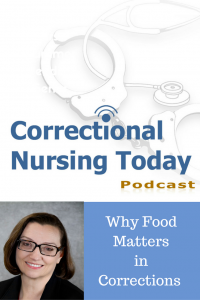 Vinneth Carvalho MD, Assistant Chief of Psychiatry at the University of Connecticut-Correctional Managed Health Care, and Amy B. Smoyer, PhD, Assistant Professor, Department of Social Work, Southern Connecticut State University in New Haven, CT join Lorry to discuss the importance of food for physical and psychosocial health. They presented a session on “Why Food Matters: Physical and Psychosocial Health of Incarcerated Women” at the 2016 National Conference on Correctional Health Care.
Vinneth Carvalho MD, Assistant Chief of Psychiatry at the University of Connecticut-Correctional Managed Health Care, and Amy B. Smoyer, PhD, Assistant Professor, Department of Social Work, Southern Connecticut State University in New Haven, CT join Lorry to discuss the importance of food for physical and psychosocial health. They presented a session on “Why Food Matters: Physical and Psychosocial Health of Incarcerated Women” at the 2016 National Conference on Correctional Health Care.
Food is a central part of prison life; all life, actually. As humans, food is used to construct identity and relationships, power, control, and even gender perceptions.
In addition, food consumption can be a critical predictor of physical health. Undereating or overeating causes long-term consequences. Obesity, in particular, can lead to diabetes, cardiovascular disease, hypertension, and cancers.
Formal and Informal Food Settings
The formal food system in a correctional setting is usually a chow hall or scheduled meal delivery to a housing unit. The informal food system might be food obtained from the commissary or sharing food among the inmates. Money to buy food can be an issue for many. For example, money sent from the outside for obtaining food can mean that the incarcerated person is not forgotten; that someone cares. Lack of money to purchase food can be demoralizing or lead to bartering services or personal items for food from other inmates.
Inmates who work in the kitchen are also part of the informal food network. Some smuggle food from their worksite for cooking or sharing in the housing unit. Inmates often build relationships through these informal means.
Obesity
Most inmates are likely to gain weight while in prison. Studies show that incarcerated women, in particular, tend to gain weight behind bars. Factors encouraging weight gain include:
- Limited movement – sedentary lifestyle in prison
- Meal size, especially for women
- Unhealthy commissary options – especially reasonably priced ones
- Psychotropic medications – especially 2nd generation
- Fewer work release options for women
- Substance use recovery – food can replace drugs or alcohol as a brain reward.
Food Allergies
The identification of true food allergies can be difficult in the correctional setting. Patients can confuse food preferences with food allergies. The most common food allergies are dairy, nuts, shellfish, and soy. A full patient history and validations of allergic response is needed. Verification in the community is also helpful. Communication with the kitchen staff is then needed so that appropriate measures are taken. Indigestion, gastric reflux, and other GI issues may be described as a food allergy and should be investigated.
How is food managed in your setting? Share your thoughts in the comments section of this post.
Leave a Reply